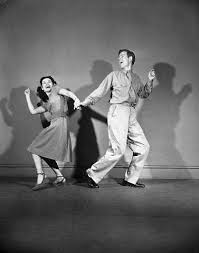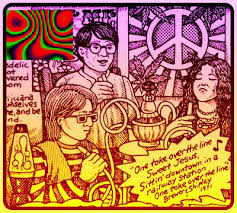
Good Day World!
Hipster, Beatnik, Hippie, and right back around to Hipster. Hip, cool, groovy, dope, deck. The terms used and names given to each generation’s “it” crowd seems to be as ingrained in history as they are in the present, but who were these groups and how did their slang come about? And how is it that we’ve had two generations of hipsters?

Hipsters
The original 1940s hipsters were so named because of their awareness and openness to a certain attitude toward life. In fact, the words “hep” and “hip” are both derivations of the African word hepi—meaning to open one’s eyes. Early jazz musicians used the word “hep” for anyone in the know, especially with regard to the black world of jazz; the musicians and their fans were known as “hepcats.” In the 1940s, when modern jazz began replacing Swing, the term “hep” had morphed into “hip,” leading to the new name for musicians and their fans—“hipsters.” A group of ultra cool jazz aficionados ablaze in their devotion for and knowledge of the art chose to espouse the relaxed lifestyle of the jazz musicians, calling themselves Hipsters as well.
This group of jazz aficionados grew and was particularly attractive to the lower class white youth, a lot of whom were frequenting African-American communities in search of alternative dance and music. It was within these urban black communities that youth looked for their fashion cues, attitudes, drug use, and language.
The language or slang used amongst this group appears to be of the utmost importa nce in defining their belief system. According to Marty Jezer, in his book The Dark Ages: Life in the U.S. 1945–1960, this limited and obscure “Hipster” language was perfect in a world that defied definition. The world of the commonplace was a world of untruth and therefore unworthy of words. Contrast this to the world of music, which was considered worthy and trustworthy. And with music there is no need for words.
nce in defining their belief system. According to Marty Jezer, in his book The Dark Ages: Life in the U.S. 1945–1960, this limited and obscure “Hipster” language was perfect in a world that defied definition. The world of the commonplace was a world of untruth and therefore unworthy of words. Contrast this to the world of music, which was considered worthy and trustworthy. And with music there is no need for words.
The world of the Hipster was so illusory that sentences were started with that word that drives modern parents crazy, such as “like.” “It’s like totally cool, man.” As if to say, maybe it’s cool, maybe it’s not; whatever you like, man. I’m not here to define your world.
Hipsters were looking for the meaning of life and they wanted to have that meaning now. They did not think in the current and divisive terms of the “free world” and “Communist bloc.” The only division was the hip and the square. The Squares believed in obtaining security through traditional methods of job, family, politics, and common social etiquette. The Hip world was one that ran together, melding the bohemian, the juvenile delinquent, and the Negro—a melting pot seeking consciousness.

Beatniks
There is definitive distinction between Jack Kerouac’s original term “Beat Generation” and “Beatnik.” Just to be clear, the Beat Generation—which did appear to give distorted rise to the “Beatnik”—was a term Kerouac devised in 1948 to describe his personal social circle, a group of New York underground anti-conformists. Kerouac’s Beat Generation was, to him, a group of blessed (beatified) and downtrodden (beaten-down) people. This group may have been downtrodden, but they were not completely down and out. They were blessed with ardent personal conviction and represented an anti-materialistic literary movement. The Beats exposed themselves to the absorption of culture through music, poetry, literature, and bumming with self-imposed poverty across America. Marijuana and other drugs didn’t hurt either.
This counterculture possessed a romantic quality, a quality of people in the know, and once the media grabbed hold of and simplified, molded, and stereotyped, it became highly marketable. Pieces of this Beat Generation were spliced together to produce the iconic, alternative intellectual bedecked in goatees, dark framed glasses, black turtlenecks, and berets—bongo drums not necessary, but always welcome.

It was in fact a member of the media, Herb Caen, a San Francisco Chronicle columnist who in 1958 with sardonic wit and his finger on the perpetual cultural pulse, satirized The Beats by adding the suffix “nik,” which was borrowed from the technological marvel at the time, Sputnik. The Beats did not embrace the term. Beat was counterculture, with a state of mind, attitude, and literature of its own. Beatniks were a subculture birthed by the media, a superficial caricature of the real thing.
Nonetheless, in the 1950s, there were plenty of middle class college students all too willing to adopt the Beatnik prerequisite dress code and form intellectual circles of their own. The women had their Beatnik style as well. In black leotards, they let their hair grow long and completely free. The fashion choice was intended to strike back at the middle class, highly coiffed beauty salon look. The Beatnik attitude was one that shunned conventional, middle-class values and strove for expression against these values by associating themselves with radical politics, cool- cat jazz, free-verse poetry readings, and excessive parties. The argument of their authenticity was irrelevant due in part to the media catapulting them into an attractively dangerous avant garde. Whereas Kerouac’s Beat Generation was beatified, the media, and ironically commercialism, exalted and helped iconize the Beatnik look and style.

Hippies
It’s claimed that Hippie is what Hipsters called their children—literally, little Hipsters. However this name came about, it’s a derivative of Hipster. As these mini-Hippies grew, they created another movement of their own, steeply based in their parent’s views on contemporary culture and political acquiescence. They rejected the established culture and swung wide to advocate extremely liberal politics and lifestyles.
This subculture was also known to listen to new and alternative music like psychedelic rock, embrace the sexual revolution, and once again use mind- expanding drugs to probe the perimeters of altered states of consciousness—all common themes amongst social subcultures.

Hippies were concerned with world peace and sustainable resources. They practiced alternative medicine and alternative lifestyles like communal living, organic and communal gardening, building “green” homes, and free love.
The Summer of Love and specifically the public display of cultural and political rebellion in the Haight-Ashbury in San Francisco brought the Hippie culture firmly into public awareness and solidified its existence. Though this kind of public spectacle also perpetuated an historical period of violence, the impact left o n society was enough to cause acute fascination by the mainstream media, thusly leading to a blossoming of hippie values and fashion statements.
n society was enough to cause acute fascination by the mainstream media, thusly leading to a blossoming of hippie values and fashion statements.
“Free love” might have been a difficult grasp for mainstream America, but organic gardening, alternative medicine, outdoor concerts, bellbottoms, miniskirts, tattoos, and body piercings seemed to take hold. Perhaps, some of these fashions and ideals and lifestyles went dormant for a while, but they were firmly lodged in the psyche of American culture.
The Modern Hipster
And now we’ve come full circle. Try to ask one of your modern Hipster friends this simple question: “What is a Hipster?” From behind overly large glasses and bedraggled hair, he or she probably won’t have an answer and might not even consider themselves one. The modern Hipster, more than any other subculture, seems to try to confute its very existence.

The ultimate goal here is to non-conform without an admission of actually doing so. Successful non-conformity is achieved through cultural irony—take anything valued within a culture, be it fashion, music, literature, or art, and use it or wear it with outright, yet subtle irony (this is more difficult to achieve than one might think). The common fashion statements seem to be that one finds some of the ugliest—yet sometimes expensive—clothing, preferably wrinkled, and looking thrown together (a lot of thought and preparation can go into this). Any type of T-shirt graphics, footwear, or eyewear worn ironically is a bonus.
However, some argue that the modern Hipster doesn’t really subscribe to a particular philosophy, genre of music, or politics. In a Huffington Post article entitled, “Who’s a Hipster?” Julia Plevin argues that the “definition of ‘hipster’ remains opaque to anyone outside this self-proclaiming, highly-selective circle.” She claims that the “whole point of hipsters is that they avoid labels and being labeled. However, they all dress the same and act the same and conform in their non-conformity to an “iconic carefully created sloppy vintage look.”
Perhaps the greatest challenge to the modern Hipster—and dare I say the ultimate irony?—is that although that hipster may consider himself totally deck (cool), unless he’s got some philosophies and politics to introduce to the world, his contribution may die with the totally ironical T-shirt in a Goodwill bin.
Image sources: Life Photo Archive, tea.. story source
TIME FOR ME TO WALK ON DOWN THE ROAD…

